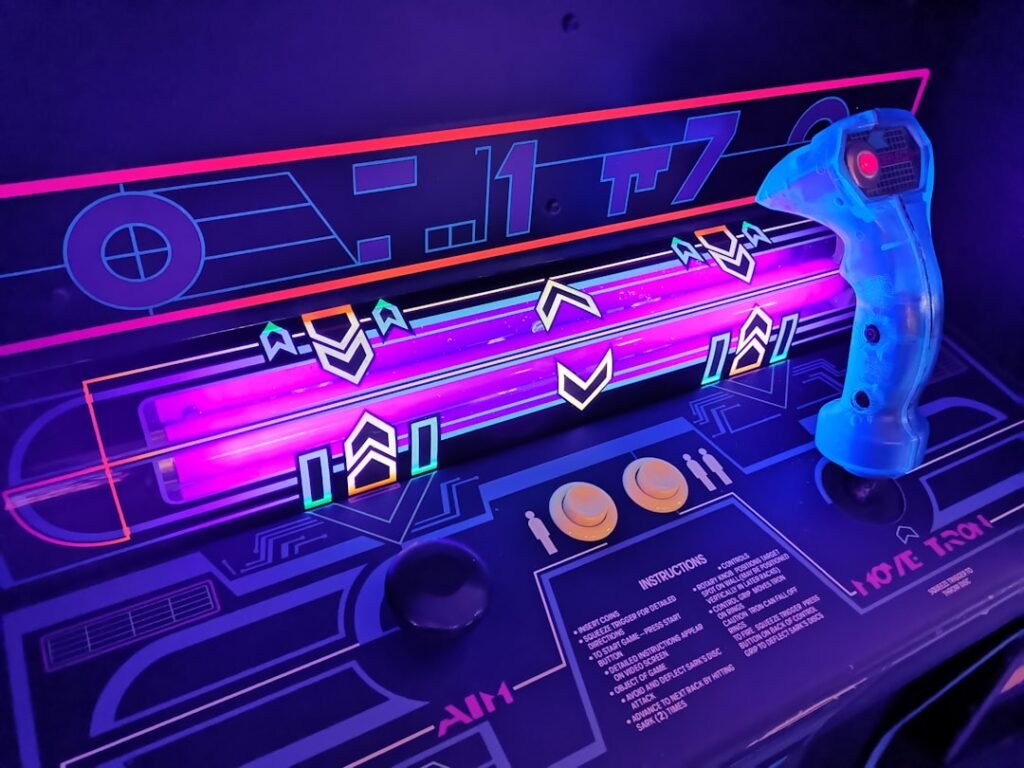Now Reading: The Rise of Playable Title Screens
-
01
The Rise of Playable Title Screens
The Rise of Playable Title Screens

As I reflect on the journey of video games, one of the most fascinating aspects is the evolution of title screens. In the early days of gaming, title screens were often simple and utilitarian, serving primarily as a gateway to the game itself. I remember the pixelated graphics and chiptune music that greeted me as I powered on my console.
These screens typically featured a static image with the game’s title prominently displayed, accompanied by a few options like “Start” or “Load Game.” They were functional but lacked the flair that would later define the medium. Over time, as technology advanced, so did the creativity behind title screens. The introduction of more sophisticated graphics and sound capabilities allowed developers to craft immersive experiences right from the start.
I’ve seen title screens evolve into elaborate animations that set the stage for the game’s narrative and aesthetic. They became an art form in their own right, often reflecting the themes and emotions that players would encounter throughout their journey. This transformation marked a significant shift in how I, as a player, engaged with games from the very first moment.
Key Takeaways
- Title screens in video games have evolved from static images to interactive and playable experiences.
- Engaging title screens are important for immersing players in the game world and setting the tone for the gaming experience.
- Modern gaming has seen a rise in interactive and playable title screens, adding a new dimension to the player’s initial interaction with the game.
- Playable title screens enhance the overall gaming experience by allowing players to engage with the game before even starting to play.
- Successful examples of playable title screens in popular video games demonstrate their impact on player engagement and retention.
The Importance of Engaging Title Screens for Player Immersion
Engaging title screens play a crucial role in establishing player immersion. When I encounter a well-designed title screen, it instantly draws me into the game’s world, creating anticipation for what lies ahead. A captivating title screen can evoke emotions and set expectations, making me feel more connected to the game even before I start playing.
It’s fascinating how a few carefully chosen visuals and sounds can create an atmosphere that resonates with me on a deeper level. Moreover, an engaging title screen serves as a first impression that can significantly influence my overall experience. If I’m met with a bland or uninspired screen, it can dampen my enthusiasm and make me question whether the game will be worth my time.
Conversely, a dynamic and visually stunning title screen can ignite my excitement and curiosity, compelling me to dive into the game with eagerness. This initial engagement is vital in today’s competitive gaming landscape, where countless titles vie for my attention.
The Rise of Interactive and Playable Title Screens in Modern Gaming

In recent years, I’ve noticed a remarkable trend: the rise of interactive and playable title screens. These innovative designs allow players to engage with the game even before the main menu appears. Instead of passively waiting for the game to load, I find myself immersed in a mini-experience that often hints at gameplay mechanics or story elements.
This shift has transformed how I perceive title screens, turning them into an extension of the gameplay itself. The interactivity of these title screens often reflects the core mechanics of the game, providing me with a taste of what’s to come. For instance, in some titles, I can explore a small area or interact with objects that foreshadow challenges I’ll face later on.
This not only enhances my anticipation but also serves as a tutorial of sorts, easing me into the game’s mechanics while keeping me engaged. The seamless integration of gameplay elements into title screens has become a hallmark of modern gaming, making each experience feel unique and tailored to my interests.
How Playable Title Screens Enhance the Overall Gaming Experience
Playable title screens significantly enhance the overall gaming experience by creating a sense of continuity between the introduction and the gameplay itself. When I engage with a playable title screen, it feels like an extension of the game world rather than a mere prelude. This continuity fosters a deeper connection to the narrative and characters, making me feel more invested in the story from the outset.
Additionally, these interactive elements often serve as a bridge between different aspects of gameplay. For example, if I’m playing an action-adventure game, the title screen might allow me to practice combat moves or explore a small environment that mirrors what I’ll encounter later on. This not only helps me familiarize myself with controls but also builds excitement for what lies ahead.
The result is a more cohesive experience that keeps me engaged and eager to continue my journey.
Examples of Successful Playable Title Screens in Popular Video Games
As I think about successful examples of playable title screens, several titles come to mind that have left a lasting impression on me. One standout is “The Legend of Zelda: Breath of the Wild.” The title screen invites me to explore a serene landscape while hinting at the vast open world I’m about to enter. The gentle music and beautiful visuals create an atmosphere that perfectly encapsulates the adventure awaiting me.
Another example is “Dark Souls,” where the title screen immerses me in its dark and foreboding world right from the start. The interactive elements allow me to engage with the environment while setting the tone for the challenging journey ahead. These experiences not only captivate my attention but also establish a strong emotional connection to the game before I even begin playing.
The Impact of Playable Title Screens on Player Engagement and Retention

Initial Engagement and Retention
The impact of playable title screens on player engagement and retention cannot be overstated. When I encounter an interactive title screen, it often compels me to invest more time in exploring its features and nuances. This initial engagement can lead to longer play sessions and increased likelihood of returning to the game later on.
Capturing Attention in a Crowded Market
In an era where players have countless options at their fingertips, capturing attention from the very beginning is essential for developers. Moreover, these interactive experiences create memorable moments that linger in my mind long after I’ve finished playing. When I think back on my gaming experiences, it’s often those unique title screens that stand out as part of my overall journey.
Building Emotional Connections and Loyalty
This emotional connection can translate into loyalty toward a franchise or developer, as I’m more likely to seek out their future titles based on my positive experiences with their engaging title screens.
Incorporating Mini-Games and Interactive Elements into Title Screens
Incorporating mini-games and interactive elements into title screens has become a popular trend that resonates with me as a player. These features not only provide entertainment while waiting for the game to load but also serve as an introduction to gameplay mechanics or story elements. For instance, when I encounter a mini-game that reflects core gameplay mechanics, it allows me to familiarize myself with controls and strategies before diving into the main content.
Additionally, these interactive elements can create a sense of achievement even before I start playing. Completing a mini-game or unlocking hidden features on the title screen gives me a feeling of accomplishment that carries over into my gaming experience. It’s fascinating how developers have found ways to make waiting for a game more engaging and rewarding through these creative approaches.
The Role of Playable Title Screens in Setting the Tone and Atmosphere of a Game
Playable title screens play a pivotal role in setting the tone and atmosphere of a game. When I first encounter a title screen, it serves as my introduction to the world I’m about to enter. The visuals, music, and interactivity all contribute to creating an emotional landscape that prepares me for what lies ahead.
For example, if I’m about to embark on a whimsical adventure, I expect bright colors and cheerful music that reflect that tone. Conversely, if I’m entering a horror-themed game, I anticipate darker visuals and unsettling sounds that evoke tension and unease. This initial atmosphere shapes my expectations and influences how I approach the gameplay experience.
A well-crafted playable title screen can effectively communicate themes and emotions that resonate throughout the entire game, enhancing my overall immersion.
Designing Effective Playable Title Screens: Tips and Best Practices
Designing effective playable title screens requires careful consideration of various elements to ensure they resonate with players like me. One key aspect is visual coherence; the design should align with the game’s overall aesthetic while providing an engaging experience. Incorporating dynamic animations or subtle movements can capture attention without overwhelming me with visual clutter.
Another important factor is interactivity; allowing players to engage with elements on the title screen can create excitement and anticipation for what’s to come. Simple mechanics like exploring environments or interacting with objects can enhance immersion while providing valuable insights into gameplay mechanics. Balancing these elements is crucial; too much complexity may detract from the experience rather than enhance it.
The Future of Playable Title Screens and Their Potential in Gaming
Looking ahead, I believe that playable title screens will continue to evolve alongside advancements in technology and player expectations. As virtual reality (VR) and augmented reality (AR) become more prevalent in gaming, I envision immersive title screens that transport players directly into the game world from the outset. Imagine stepping into a fully realized environment where every interaction feels seamless and intuitive.
Furthermore, as developers explore new storytelling techniques, playable title screens may become integral to narrative development. They could serve as interactive prologues that allow players to shape their experiences even before starting the main game. This potential for innovation excites me as it opens up new avenues for creativity within gaming.
Exploring the Psychological and Emotional Effects of Playable Title Screens on Players
The psychological and emotional effects of playable title screens are profound yet often overlooked aspects of gaming design. When I engage with an interactive title screen, it creates an immediate emotional connection that influences my overall experience. The anticipation built during this initial phase can heighten my excitement and investment in the story.
Moreover, these experiences can evoke nostalgia or familiarity based on previous encounters with similar designs or themes. As I navigate through various titles, certain elements may trigger memories or feelings associated with past gaming experiences, deepening my emotional engagement with new games. Understanding these psychological effects allows developers to craft more impactful experiences that resonate with players like me on multiple levels.
In conclusion, playable title screens have evolved from simple static images into dynamic experiences that enhance player immersion and engagement. As technology continues to advance, I look forward to seeing how developers innovate within this space, creating memorable moments that resonate long after I’ve put down the controller. The potential for creativity is limitless, and I am excited about what lies ahead in this ever-evolving landscape of gaming.
The new trend of playable title screens in video games has been gaining popularity among gamers. This innovative approach to engaging players from the moment they start up a game has been well-received by the gaming community. For more information on the latest multiplayer games that feature playable title screens, check out this article on top multiplayer game reviews.



























